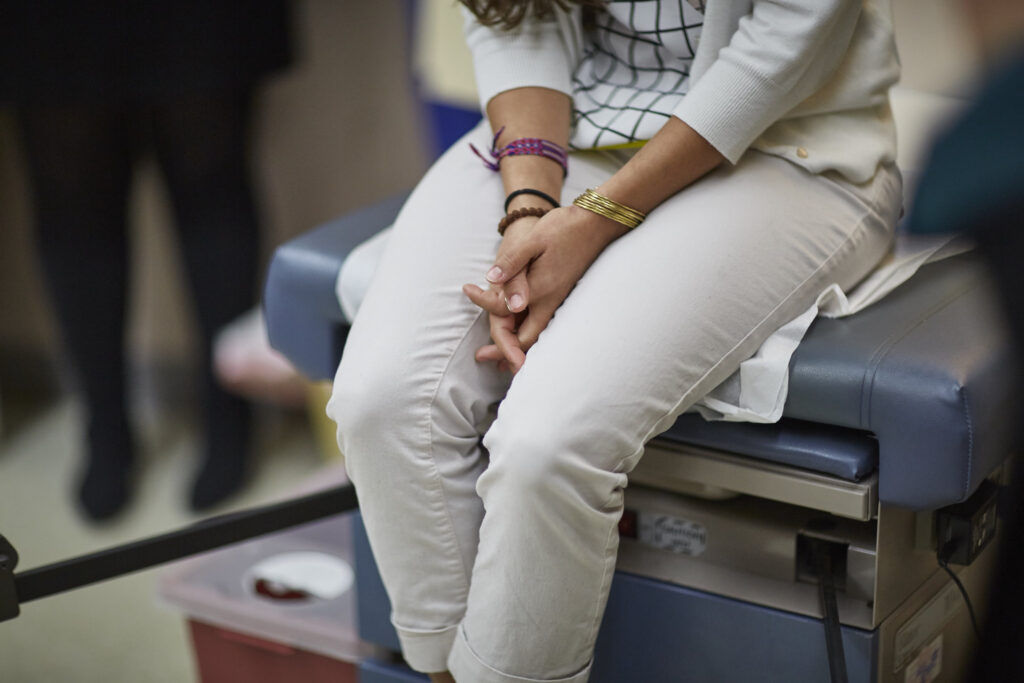Across the country, hospitals are in frantic need of personal protective equipment (PPE) to keep their staff safe while treating patients with COVID-19. Unfortunately, with the national stockpile now depleted, governors are trying to find PPE anywhere they can. In several states, governors have tried to conserve PPE through an alternative method: by banning abortion.
The idea that blocking abortion would free up much needed PPE is laughable.
In Texas, Attorney General Ken Paxton claims that because abortion is not an essential health service, procedures should be banned during the stay-at-home period, and that stopping abortions will help free up PPE such as gloves, masks, and gowns for providers tending to patients infected with coronavirus. Other states, including Alaska, Iowa, Ohio, and Oklahoma, have tried to impose similar bans. But this is a baseless argument—and it could actually put people in more danger.
The first problem with the argument is a bad premise: abortion is, of course, essential health care. It cannot be delayed and becomes less accessible as time passes because of the medically unnecessary laws anti-abortion legislators have enacted over the past decade. At this point, it’s unclear how long the pandemic will last. It is irresponsible and unjust to ask a patient to continue to stay pregnant while waiting an indefinite amount of time for a time-sensitive procedure, not to mention the stress of not knowing whether they will be able to get care.
But setting that question aside, is this attempt to circumvent a patient’s constitutional right to an abortion worth the amount of PPE that supposedly would be saved? Looking at the evidence, the answer is a resounding no.
• • •
There is no question that health care providers on the front lines of COVID-19 are facing a dire shortage of PPE and hospital beds. But the idea that blocking abortion would free up these resources is laughable. When I provide a first-trimester abortion in a clinic, here’s what I put on in terms of PPE: a pair of gloves and a reusable face shield. Another pair of gloves may be needed for the ultrasound. That’s it. A gown and mask are not usually required. Of course, currently all patients and health care workers wear masks in medical facilities, but those masks are used throughout the day and only changed if they become wet or dirty.
By contrast, if a pregnant person continues their pregnancy, more PPE will be used. They’ll have a few pelvic exams and ultrasounds during prenatal check-ups, all of which require gloves. Providers then use multiple sterile gloves and other PPE during delivery, and even more during a C-section. Cancelling abortions is not going to free up enough PPE for hospitals—especially considering that two million new masks are being manufactured for hospital use in Texas every week to try to meet the PPE demand.
When I provide a first-trimester abortion in a clinic, I put on a pair of gloves and a reusable face shield. Another pair of gloves may be needed for the ultrasound. That’s it.
The supposed relationship between abortion and strain on hospitals is also a fallacy. In fact, very few abortions in Texas are performed in hospitals. According to the state’s official statistics, 52,103 abortions were performed for Texas residents in 2017, the most recent year data are available. Only 87 of those were performed at a hospital. That’s 0.17 percent of all abortions.
Abortion complications that require a hospital visit are also extremely rare. According to a study from California, less than 1 percent of abortion patients went to an emergency room from 2009 through 2010 for a complaint related to an abortion, and only 0.2 percent had a complication requiring treatment at a hospital. In a national study, only 0.01 percent of all emergency department visits among women aged 15 through 49 were related to a recent abortion.
In other words, banning abortion will not save hospitals space that could be used for COVID-19 patients. Instead, when patients are driven to self-manage their abortions because of the bans, studies show some will use unsafe methods and then go to the emergency room if they have complications—or to know if they’re still pregnant.
Bans will also not stop people from needing abortions. If state officials really wanted to protect residents during this crisis, they would move to make abortion care more accessible, not less.
In Texas alone, tens of thousands of patients need abortion care every year. When the state’s total ban initially went into effect on March 23, traveling across state lines to reach clinics was the only option. Abortion providers in Texas challenged the ban, and after a dizzying back-and-forth between the district and appeals courts, at the moment only medication abortion up to ten weeks of pregnancy may be provided in the state. A recent analysis by the Texas Policy Evaluation Project found that 72 percent of Texas counties are more than 200 miles from the nearest out-of-state abortion-providing facility, which is the only option for a patient needing a surgical or aspiration procedure. This increase in travel means more time off work, more need for childcare, more gas money, more lodging expenses, and more potential contact with others—counter to the social distancing recommendations made by the Centers for Disease Control and Prevention.
The supposed relationship between abortion and strain on hospitals is also a fallacy. In fact, very few abortions are performed in hospitals.
Some people won’t be able to make that trip, perhaps out of safety concerns for themselves or loved ones in the face of this potentially deadly virus. They will be forced to delay their procedure—if they can get it at all. The longer they have to wait, the more complicated and expensive obtaining it will become, especially in places with medically unnecessary restrictions like state-mandated waiting periods, ultrasound requirements, and gestational limits. Given that many patients seek abortion for economic reasons, such as a desire to better care for children they already have, it is particularly unconscionable that officials would declare it “non-essential” when the United States is facing a devastating recession. Abortion funds have already reported an uptick in requests from people who can’t afford to get care. Bans like these just make things worse.
Still others will decide to self-manage their abortions. While there are safe and effective methods for doing so, people who take this route face legal risks. The dangers are heightened for low-income women, undocumented women, and women of color.
• • •
There are ways states could make abortion more accessible during this pandemic, as places like England have already done by expanding the use of telehealth to provide medication abortion. Guidance from the Royal College of Obstetricians and Gynaecologists recommends screening patients over the phone or by video to determine if they are eligible for medication abortion and then mailing patients the pills for use at home. Many patients will never have to come to the clinic, which is the best way to provide health care during a pandemic. There has also been a big push toward telemedicine in the United States in the face of coronavirus, but not for abortion care.
Research has shown that telemedicine is a safe and effective way to provide medication abortion; it’s also well-liked by patients and improves access to early abortion. In the United States, telemedicine is being used to extend the reach of clinicians to provide abortion to patients who are seen at a facility that does not have a doctor on site, which is especially useful for states with a dearth of abortion doctors or many rural patients.
If state officials really wanted to protect residents during this crisis, they would move to make abortion care more accessible, not less.
Unfortunately, Texas is among the eighteen states that ban the use of telemedicine to provide abortion care. And because of outdated Food and Drug Administration (FDA) regulations, mifepristone—one of the two medications used in abortion—can’t be mailed to a patient. Patients also can’t fill prescriptions for mifepristone at a pharmacy. Instead, it must be dispensed in a doctor’s office, clinic, or hospital. This makes no medical sense, and a growing chorus of medical groups and politicians are calling on the FDA to lift these restrictions.
It is clear, however, that officials in states like Texas will leap at every chance they get to undercut the constitutional right to abortion care. Apparently it is not enough for them to enact restrictions that shutter clinics or force patients to wait between appointments to obtain an abortion. During this literal life-or-death crisis, they have chosen to prioritize their own agenda.
Abortion is an essential health service, and banning it certainly won’t make hospital workers safer. Instead, it will put everyone at greater risk.








